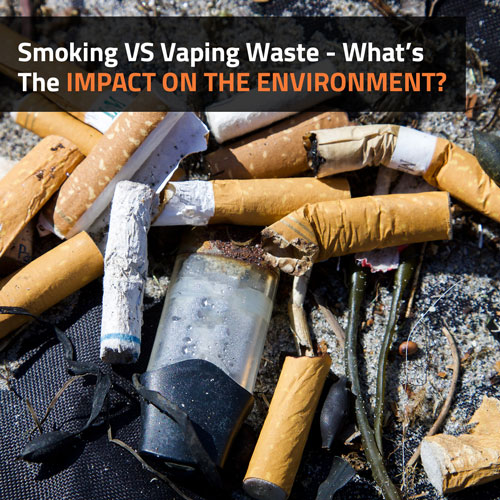The impact we as people have on the environment has never been more under a microscope as it has been in the last 5 years. The woke culture that we currently live in has a lot of people being more conscious about how their lifestyle choices affect the environment. People around the world have undergone huge lifestyle changes, all in the spirit of reducing their carbon footprint and attempting to have less of an impact on the environment.
Lifestyle changes from veganism, to eco-friendly enthusiasts to minimalists all started as a way to minimise our impact on the environment. However, very rarely do we ever look into the impact that e-cigarettes and over vaping paraphernalia has on the environment. Understanding just how much waste is produced from the vaping industry is the start to being able to minimise or even completely eliminate toxic e-waste.
What We Know Now
Scientific research regarding the environmental impact of manufacturing, using and disposing of vapes and vape products is very limited. The vaping industry is still pretty much in its infancy and as such there are a lot of significant aspects regarding the industry that still need to be scrutinised and regulated – the environmental impact of vaping is atop of that list.
Currently, there are no formal studies being conducted to investigate and evaluate the impact that the manufacturing process as well as the disposal of vape components has on the environment. However, apart from the research that is not being conducted, manufacturers also don’t disclose vital information like how to dispose of spent cartridges. Furthermore, they go as far claiming that their devices or products are “eco-friendly” but fail to provide any data that supports this claim. Ultimately, the impact smoke and vape waste has on the environment is an emerging issue that warrants the attention of the public – both vapers and non-vapers alike.
How Big Is The Problem?
Across the world, cigarette butts and other e-cigarette paraphernalia are callously thrown away. In fact, cigarette butts alone are one of the biggest culprits responsible for clogging sewage drains. However, because of their dense material composition, e-cigarettes and their related products could potentially cause an even bigger environmental threat.
In the US, there were over 58 million e-cigarettes sold in 2015, and 19.2 million of them were disposable devices. With the use of e-cigarettes being a fairly common practice in many countries across the globe, it is understandable how e-waste is quickly becoming an overwhelming problem.
In 2017, global estimates of inappropriately discarded e-waste was sitting at 99 billion pounds – which is roughly equivalent to 45 billion kilograms. The vaping industry in South Africa is a R1.25 billion industry, with approximately 400 000 people using some form of e-cigarette products. This means that locally, we too are producing a fair amount of e-waste and nobody, from distributors to vapers, really knows how to dispose of this waste correctly.
What Are The Dangers Of E-Cigarette Waste?
A lot of e-cigarette devices and other vaping accessories are made from non-biodegradable materials that contain enough harmful chemicals to qualify as toxic waste. In addition to that, the electronic circuitry is known to release toxic acids that when left out in the elements can ultimately contaminate the soil. And if that isn’t enough, e-cigarettes are designed to be small and compact, this poses a choking hazard for small children and animals. In recent years, environmentalists, ornithologists and ichthyologists have associated spikes in deaths of small birds and fish to an increase in inappropriately disposed e-cigarette waste.
Disposable vapes pose the most significant environmental danger due to their short use life span. A lot of these devices are thrown away in the trash or littered in the environment as soon as they are empty. Disposable devices are made from the same type of non-biodegradable materials as refillable devices, thus releasing the same types of toxic and harmful by-products.
How To Dispose Of E-Cigarette Waste?
Spent e-cigarettes and other vaping paraphernalia should be recycled. It is not advised for these products and devices to be thrown and discarded as regular trash. The burden to properly recycle these devices should fall on the manufacturer in a process known as extended producer responsibility – which is something a lot of vape manufacturers do not do.
The extended producer responsibility is similar to how phone companies encourage customers to bring in their old devices to get the latest upgrade. This has worked well in the smartphone industry and seeing that there are many similarities between vape devices and smartphones, it is safe to assume that the model can work. The vaping industry needs a sustainable recycling ecosystem and to make this work all stakeholders need to be involved, from lawmakers to manufacturers and distributors as well as users.
What Needs To Happen Moving Forward?
Not a lot of research has been conducted on this, however, the little that has been done suggests that everything from cigarette butts to damaged refillable pods and other vaping accessories are often thrown away with regular trash and this is not good for the environment.
This suggests that several steps need to be taken in order to minimise or even eliminate the catastrophic harm that e-cigarette waste poses to the environment by:
- Mandating extended producer responsibility initiatives
- Flavouring reusable devices that only need to be repaired
- Phasing out the production of disposable or single use devices
- Encouraging manufacturers to produce more robust and durable products
This can be achieved by establishing laws, policies and regulations that both manufacturers and e-cigarette users have to abide by. This would require implementation of stringent product standards that are environmentally friendly.
Firstly, manufacturers can invest in producing more environmentally friendly products and devices, in addition to showing customers how to dispose of their e-cigarette waste. Mandating an extended producer responsibility program for manufacturers will encourage them to minimise the use of non-biodegradable materials. Secondly, laws and regulations need to be established that ensure that manufacturers are providing customers with proper disposal practices to minimise the environmental impact by users.
The burden of environmental callousness is always felt more by vulnerable populations. A significant amount of the Western countries waste lands on the doorstep of many developing countries in Africa. This poses an even greater health risk to countries that don’t have the infrastructure to handle the burden.







